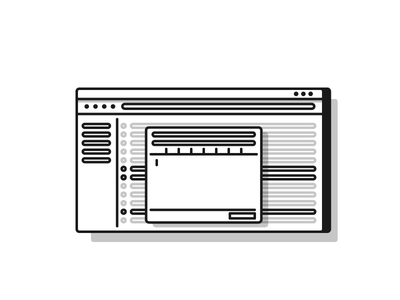 The scariest part of web design, at least from a clients perspective is the content. Lets face it, the client knows that you are going to handle all the coding, hopefully the graphics, and maybe throw in a logo for their business. But when it comes to the content, or text, they know they are responsible for at least that part.
The scariest part of web design, at least from a clients perspective is the content. Lets face it, the client knows that you are going to handle all the coding, hopefully the graphics, and maybe throw in a logo for their business. But when it comes to the content, or text, they know they are responsible for at least that part.
Too many times have I been confronted by a client who tells me, just put what you think…. I really don’t like when a client tells me this because for one, it shows they do not understand how the web works. Your potential customers actually read your website, and if you don’t have great content to fill that void, then you can count on your competitor getting their business. It doesn’t matter if you write the content on a word processing application, like Microsoft Word or Notepad, a typewriter or a pen and sheet of paper, the fact is that you need to write something.
Ultimately you understand your company more than anyone else, and you know what to say when people ask about your company. I try to tell my clients to think of the website as a friendly sales pitch, one that is very descriptive, informative and full of detail. If you are having trouble writing content for your site, here are a few things to keep in mind when you start writing your content.
Create an Outline
You can never escape the outline, it is the building blocks for starting almost anything. I like to create an outline before i start a clients website, just so I can see the direction I am heading in. When you create an outline it forces you to think about what you want to write and how to organize it. You don’t need a lot of detail in your outline. But at least list your major points. Then think about what it takes to fill those short lines in, and revise and/or reorder if need be. Once your done, well you have a map that will guide you through your writing
Solve a problem
Readers love when you do this, show them how to solve a problem that is. They want information and your writing is what will fill that need. This is not a contest to prove how well you can write, and you need to concentrate on what the reader wants to know, instead of impressing them. Worry about offering complete information, not the words.
Start in the middle
This is especially helpful if you have writers block. Introductions for any piece of work can be tricky, by doing this you can start writing sooner, and worry about the introduction later. The best way to do it is to start right by pointing out your arguments, or information, then going back and writing the introduction to fit into the whole thing.
Respect their vocabulary
In no way does this mean, “dumbing down” your content, but use your readers language. This helps to keep your words within their world, and it creates a bond between you and the reader. They will assume you are one of them (and not an alien 🙂 if you use words they use. They will feel more comfortable with you, and ultimately your company, when you use their words.
Using jargon related to your company, profession, or trade can be impossible to understand by an outsider. So try not to use it, or if you have to, provide an explanation of what it is your are talking about
“Jargon – acronyms and terms specific to your field or industry”
Don’t fall in love with your words
Unless this is a poetry website, or your writing love songs, then your readers are not looking for lovely language. There will be times while your writing that you impress yourself with big words. So don’t spend too much time in the Thesaurus trying to sound like a genius. Keep it simple, and at the same time, professional.
Be concise.
Have you ever heard the term, “Use one word instead of two”? Tight language is easier to read, and moves the reader along quickly
Write it as long as it needs to be
Obviously if you are writing to be technical, or writing instructions or directions then your content may be lengthy. Basically, once you get the point across to the reader, there really is nowhere else to go.
Dont worry about grammar too much
Unless your audience is made of high school English teachers, then a lot of the commonly held grammar rules are not important. This doesn’t mean that none of the grammar rules apply. You don’t want to write all your content to look like the text messages your teenage daughter sends you.
In summary:
These are good tips to help if you are having writers block. Even if you are not having writers block, this is a good guideline to help you write more efficiently. Writing for the web is a little different then writing for other things. These guidelines will help you improve your writing and communication, and help when it comes to creating content for your website, product or services.
The scariest part of web design, at least from a clients perspective is the content. Lets face it, the client knows that you are going to handle all the coding, hopefully the graphics, and maybe throw in a logo for their business. But when it comes to the content, or text, they know they are responsible for at least that part.
Too many times have I been confronted by a client who tells me, just put what you think…. I really don’t like when a client tells me this because for one, it shows they do not understand how the web works. Your potential customers actually read your website, and if you don’t have great content to fill that void, then you can count on your competitor getting their business. It doesn’t matter if you write the content on a word processing application, like Microsoft Word or Notepad, a typewriter or a pen and sheet of paper, the fact is that you need to write something.
Ultimately you understand your company more than anyone else, and you know what to say when people ask about your company. I try to tell my clients to think of the website as a friendly sales pitch, one that is very descriptive, informative and full of detail. If you are having trouble writing content for your site, here are a few things to keep in mind when you start writing your content.
Create an Outline
You can never escape the outline, it is the building blocks for starting almost anything. I like to create an outline before i start a clients website, just so I can see the direction I am heading in. When you create an outline it forces you to think about what you want to write and how to organize it. You don’t need a lot of detail in your outline. But at least list your major points. Then think about what it takes to fill those short lines in, and revise and/or reorder if need be. Once your done, well you have a map that will guide you through your writing
Solve a problem
Readers love when you do this, show them how to solve a problem that is. They want information and your writing is what will fill that need. This is not a contest to prove how well you can write, and you need to concentrate on what the reader wants to know, instead of impressing them. Worry about offering complete information, not the words.
Start in the middle
This is especially helpful if you have writers block. Introductions for any piece of work can be tricky, by doing this you can start writing sooner, and worry about the introduction later. The best way to do it is to start right by pointing out your arguments, or information, then going back and writing the introduction to fit into the whole thing.
Respect their vocabulary
In no way does this mean, “dumbing down” your content, but use your readers language. This helps to keep your words within their world, and it creates a bond between you and the reader. They will assume you are one of them (and not an alien 🙂 if you use words they use. They will feel more comfortable with you, and ultimately your company, when you use their words.
Using jargon related to your company, profession, or trade can be impossible to understand by an outsider. So try not to use it, or if you have to, provide an explanation of what it is your are talking about
“Jargon – acronyms and terms specific to your field or industry”
Don’t fall in love with your words
Unless this is a poetry website, or your writing love songs, then your readers are not looking for lovely language. There will be times while your writing that you impress yourself with big words. So don’t spend too much time in the Thesaurus trying to sound like a genius. Keep it simple, and at the same time, professional.
Be concise.
Have you ever heard the term, “Use one word instead of two”? Tight language is easier to read, and moves the reader along quickly
Write it as long as it needs to be
Obviously if you are writing to be technical, or writing instructions or directions then your content may be lengthy. Basically, once you get the point across to the reader, there really is nowhere else to go.
Dont worry about grammar too much
Unless your audience is made of high school English teachers, then a lot of the commonly held grammar rules are not important. This doesn’t mean that none of the grammar rules apply. You don’t want to write all your content to look like the text messages your teenage daughter sends you.
In summary:
These are good tips to help if you are having writers block. Even if you are not having writers block, this is a good guideline to help you write more efficiently. Writing for the web is a little different then writing for other things. These guidelines will help you improve your writing and communication, and help when it comes to creating content for your website, product or services.

